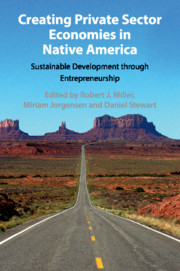 Creating Private Sector Economies in Native America
Creating Private Sector Economies in Native America from Part II - Policy Barriers and Policy Needs
Published online by Cambridge University Press: 15 October 2019
This chapter explores the link between entrepreneurship and the larger project of reservation land tenure reform. Many scholars draw a connection between land-tenure design and economic development generally. This chapter provides a more detailed analysis of current reservation land tenure dynamics and the specific challenges these systems can create for private economic development. Despite this current system’s widely recognized economic and non-economic perils, successful reservation land reforms have proven incredibly difficult to achieve. In order to encourage more land-tenure innovation, this chapter flips the land reform conversation on its head. Instead of focusing solely on land reform strategies to promote economic development, this chapter explores how supporting entrepreneurship itself might, in turn, drive more experimental, innovative, and flexible land reform. Entrepreneurs tend to thrive in the kind of uncertain legal environment that is otherwise seen as a problem in Indian country, and entrepreneurs might therefore be uniquely well suited to navigate reservation legal landscapes in creative ways. Entrepreneurship can be a powerful catalyst both to improve reservation economies and to support Indigenous efforts to reclaim and sustain local land ethics and property law choices.
To save this book to your Kindle, first ensure no-reply@cambridge.org is added to your Approved Personal Document E-mail List under your Personal Document Settings on the Manage Your Content and Devices page of your Amazon account. Then enter the ‘name’ part of your Kindle email address below. Find out more about saving to your Kindle.
Note you can select to save to either the @free.kindle.com or @kindle.com variations. ‘@free.kindle.com’ emails are free but can only be saved to your device when it is connected to wi-fi. ‘@kindle.com’ emails can be delivered even when you are not connected to wi-fi, but note that service fees apply.
Find out more about the Kindle Personal Document Service.
To save content items to your account, please confirm that you agree to abide by our usage policies. If this is the first time you use this feature, you will be asked to authorise Cambridge Core to connect with your account. Find out more about saving content to Dropbox.
To save content items to your account, please confirm that you agree to abide by our usage policies. If this is the first time you use this feature, you will be asked to authorise Cambridge Core to connect with your account. Find out more about saving content to Google Drive.